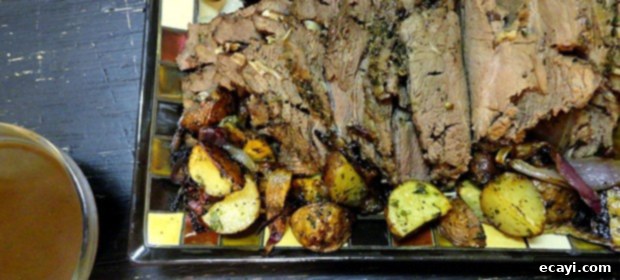Mastering the Perfect Sirloin Roast Beef: A Succulent Sunday Dinner Recipe Guide
There are some culinary memories that stay with you, shaping your palate and inspiring your own kitchen adventures. For me, one such indelible memory dates back to my early twenties, visiting a friend’s parents’ home for dinner. Her mother had a way with a sirloin roast that was simply unparalleled – consistently tender, incredibly juicy, and served with a side of spectacular potatoes, a crisp salad, crusty rolls, and rich, savory pan juices. That meal, a symbol of warmth and comfort, became my gold standard, the elusive flavor profile I tirelessly sought to recreate in my own kitchen.
For many years, my attempts at replicating that perfect Sunday roast yielded delicious results, but none quite captured the magic of those cherished memories. I tried countless sirloin roast beef recipes, experimented with various techniques, yet the precise balance of flavor and tenderness remained just out of reach. That is, until now. If you, like me, have been on a quest for the ultimate Sunday roast – a dish that embodies comfort, flavor, and effortless elegance – then your search ends here. This recipe delivers the perfect sirloin roast, promising a dining experience that will have your family raving. And if you’re a fan of succulent roasts, you’ll also adore my incredibly juicy sirloin pork roast recipe as well!
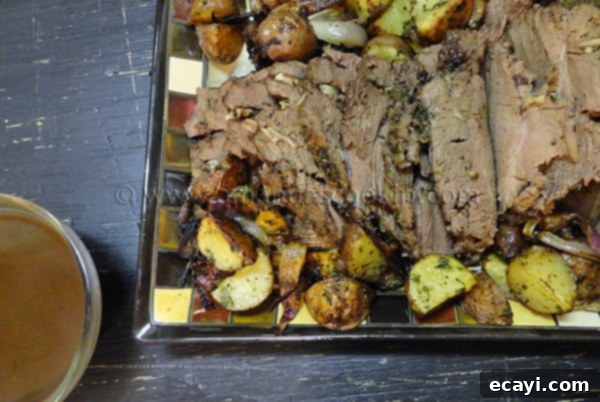
A Culinary Discovery: Unlocking the Secrets of Sunday Roasts
My breakthrough came with the arrival of the cookbook Sunday Roasts by Betty Rosbottom. As soon as it landed in my hands, I was captivated. I immediately started thumbing through its pages, finding myself circling back to the beginning to jot down page numbers of every recipe I yearned to try. The book is a treasure trove of classic, comforting roasts, from the Old Fashioned Pot Roast on page 18, which uses a chuck or arm roast and is definitely next on my list, to the intriguing Rolled Flank recipe on page 30, and the delightful Bistro Roast Chicken on page 92. There were so many tempting options, but I decided to start with the cover recipe: a sirloin tip roast. Fortuitously, I already had a sirloin tip roast in my freezer, making it the perfect first experiment. If you have a passion for roasting, I wholeheartedly recommend this invaluable cookbook!
This particular sirloin roast recipe, I can confidently say, is truly amazing. It has earned a coveted spot among my family’s favorite meals, right alongside my “To Die For Pot Roast” for the slow cooker. Each bite is mouth-watering, bursting with rich flavor, and incredibly juicy and tender. The beauty of using sirloin is its natural tenderness, which means it requires a surprisingly short time in the oven – typically about an hour. Factor in a couple of hours before dinner for thorough preparation and the essential resting time for the roast, and you’ll have a magnificent meal ready to impress.
Beyond the Roast: Perfectly Paired Vegetables and Gravy
A glorious roast isn’t complete without equally delicious accompaniments. Alongside the star of the show, this recipe guides you in creating savory roasted vegetables. While the original recipe called for red onions and mushrooms, I’ve adapted it to include quartered small red potatoes, which have become a family favorite. The printable version below includes this delicious addition. Imagine vibrant red onions, earthy mushrooms, and tender potatoes, all tossed generously with fragrant olive oil and a medley of fresh herbs. The aroma alone is enough to make your mouth water!
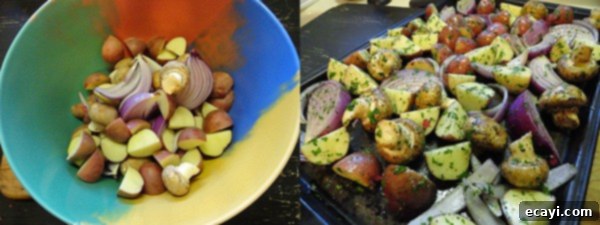
The roasting process transforms these simple ingredients, softening the onions, intensifying the mushroom flavor, and crisping the potato skins to golden perfection. The subtle charring around the edges adds another layer of irresistible taste and texture. Placed on the lower rack of the oven, they roast in harmony with the sirloin, absorbing some of the meat’s savory drippings while developing their own unique character.
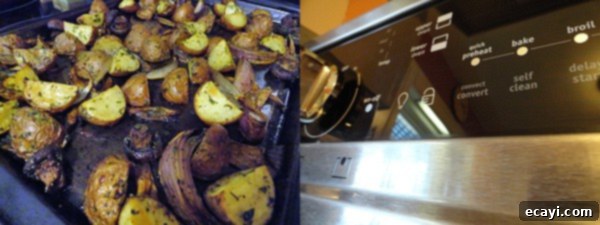
Leveraging Technology: The Advantage of a Convection Oven
For this particular roast, I had the pleasure of utilizing my new Frigidaire Symmetry Double Oven, specifically employing its True Convection option. It’s a fantastic feature, offering both convection bake and convection roast settings. Having not had a convection oven since my days living in Vegas, this return to convection cooking has been an absolute delight and a truly welcome option! Convection technology works by circulating hot air evenly throughout the oven cavity. This constant airflow results in more efficient and significantly faster cooking and roasting times. It ensures that the roast cooks evenly and develops a beautiful, consistent crust, while the vegetables achieve perfect tenderness and a lovely golden-brown finish.
To adapt the recipe’s conventional oven temperature for my convection setting, I used the oven’s convect convert pad – and it worked like a dream! This intelligent feature takes the guesswork out of adjusting temperatures, making the transition to convection seamless. While a conventional oven will certainly yield excellent results with this recipe, a convection oven offers the advantage of superior heat distribution, often leading to quicker cooking times and more uniform browning. If you have a convection oven, I highly recommend using it to experience the full benefits of its even-heat capabilities for your sirloin roast.
Crucial Steps for a Flawless Roast: Temperature and Resting
Achieving a truly tender and juicy sirloin roast hinges on a couple of critical factors. First, ensure your roast starts at room temperature. I made the mistake once of putting a very cold roast directly into the oven, and even after the recommended time, it was still quite cold in the center. Allowing the meat to come to room temperature for about an hour before roasting promotes more even cooking throughout the entire cut. This prevents the outer layers from overcooking while the inside struggles to reach the desired temperature. Optimal results truly begin with a room-temperature roast.
Second, and perhaps most importantly, do not skip the resting period. Once your sirloin roast reaches the target internal temperature (130-135°F for medium-rare, keeping in mind it will continue to cook a few degrees as it rests), transfer it to a cutting board and allow it to rest, loosely tented with foil, for at least 20 minutes. This resting phase is absolutely vital. It allows the meat’s internal juices, which have been pushed to the center during cooking, to redistribute evenly throughout the roast. Skipping this step means cutting into the meat too soon, resulting in a pool of delicious juices on your cutting board instead of locked within each tender slice.
While the original cookbook recipe suggested topping the roasted vegetables with sliced blue cheese, I opted for a more personalized touch. Not being a fan of blue cheese myself, and with a strong desire for those hearty potatoes, I tailored the vegetable component. I reduced the quantity of onions and mushrooms slightly and generously added those delightful quartered small red potatoes. This adaptation perfectly complemented the sirloin and created a more complete, satisfying meal for my family. Enjoy this wonderful recipe, whether you follow it precisely or add your own personal flair!
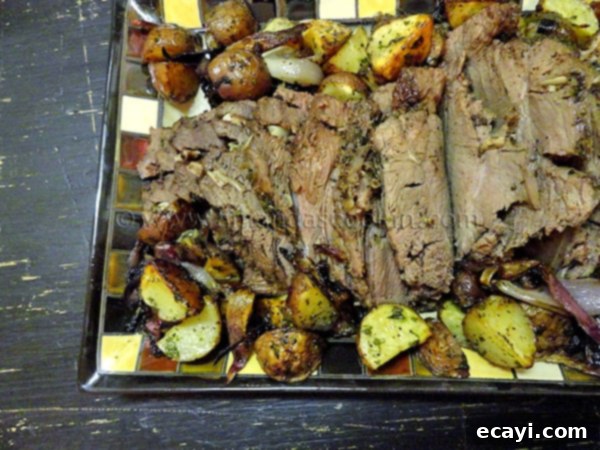
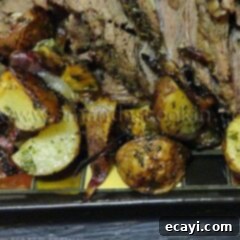
Perfect Sunday Roast
IMPORTANT – There are often Frequently Asked Questions within the blog post that you may find helpful. Simply scroll back up to read them!
Print It
Pin It
Rate It
Save ItSaved!
Ingredients
- 1 4- lb boneless top sirloin roast
- 5 cloves garlic peeled and slivered
- 1 teaspoon dried thyme leaves
- 1 teaspoon fresh winter savory minced
- 1 teaspoon fresh oregano minced
- Kosher salt
- Freshly ground black pepper
- 3 tablespoons + 1/2 cup olive oil
- 1 medium red onion
- 1 cup whole white mushrooms
- 3 cups quartered small red potatoes
- 1 ½ cups beef broth
- ¾ cup Shariz or other dry red wine
- 1 ½ tablespoons unsalted butter
Before You Begin
Also, I used winter savory and oregano because I still have it growing outside. You can just use 2 teaspoons of dried thyme or substitute your own favorite herbs.
Instructions
-
Rinse and thoroughly dry the roast. It is crucial that the meat reaches room temperature before cooking, so allow it to rest for about an hour on the counter. Use a sharp paring knife to make small slits evenly over the entire surface of the roast and carefully insert the garlic slivers into these openings. This infuses the roast with deep garlicky flavor.
-
In a small bowl, combine the dried thyme leaves, fresh winter savory (if using, otherwise adjust thyme), fresh oregano (if using), 1 1/2 teaspoons of Kosher salt, and 1/2 teaspoon of freshly ground black pepper. Pour in 3 tablespoons of olive oil and mix well to form a fragrant paste. Generously brush this herb and oil mixture on all sides of the boneless top sirloin roast, ensuring it is fully coated for maximum flavor and a beautiful crust.
-
Position your oven rack in the center for even heat distribution. Preheat your oven to a high temperature of 450°F (232°C). This initial high heat will help to sear the outside of the roast, locking in juices and developing a rich, flavorful crust.
-
Lightly oil or spray the bottom of a sturdy roasting pan to prevent sticking. Place the seasoned sirloin roast directly in the center of the pan, ensuring the fat side is facing up. This allows the fat to render and baste the meat as it cooks. Roast in the preheated oven at 450°F for exactly 15 minutes.
-
While the roast is getting its initial high-heat sear, prepare your vegetables. Lightly oil or spray a large, rimmed baking sheet. Peel the red onion and cut it into neat wedges, making sure to leave the root end intact to hold the layers together during roasting. In a large bowl, combine the onion wedges, whole white mushrooms, and quartered small red potatoes. Drizzle with the remaining 1/2 cup of olive oil, then season generously with fresh ground black pepper and Kosher salt. Toss everything together thoroughly until the vegetables are evenly coated. Spread the seasoned vegetables in a single layer on the prepared baking sheet.
-
After the initial 15 minutes of roasting for the meat, reduce the oven temperature to 350°F (175°C). Carefully place the baking sheet with the prepared vegetables on the lower rack of the oven. Continue to roast the meat and vegetables for an additional 50-60 minutes, or until a meat thermometer inserted into the thickest part of the sirloin registers an internal temperature of 130-135°F for medium-rare doneness. During this time, stir the vegetables every 15 minutes to ensure even browning and charring around the edges, until they are tender and caramelized.
-
Once the roast reaches the desired internal temperature, immediately transfer it from the roasting pan to a clean cutting board. Tent the roast loosely with foil to keep it warm and allow it to rest for a crucial 20 minutes. At this point, check the vegetables for doneness; if they are not yet fork-tender and beautifully browned, continue to roast them until they reach perfection. Once done, remove the vegetables from the oven and tent them with foil as well.
-
While the meat rests, prepare the flavorful pan gravy. Carefully skim off and discard any excess fat from the roasting pan, leaving behind the precious flavorful drippings and browned bits (fond). Place the roasting pan directly over medium heat on your stovetop. Add the beef broth and dry red wine (like Shariz) to the pan. Use a wooden spoon or spatula to scrape up all the delicious browned bits from the bottom of the pan, deglazing it thoroughly. Bring the mixture to a gentle simmer and reduce by half, allowing the flavors to concentrate. Swirl in the unsalted butter until it melts and emulsifies into the gravy, creating a rich, glossy finish. Season the gravy to taste with salt and pepper.
-
After the roast has rested, slice it crosswise against the grain into beautiful 1/4-inch thick slices. Arranging the tender, juicy slices of meat artfully on a serving platter, then surround them with the perfectly roasted red onions, mushrooms, and potatoes. Drizzle some of the exquisite pan gravy directly over the sliced meat before serving, and pass the remaining gravy at the table for guests to enjoy.
The recipes on this blog are tested with a conventional gas oven and gas stovetop. It’s important to note that some ovens, especially as they age, can cook and bake inconsistently. Using an inexpensive oven thermometer can assure you that your oven is truly heating to the proper temperature. If you use a toaster oven or countertop oven, please keep in mind that they may not distribute heat the same as a conventional full sized oven and you may need to adjust your cooking/baking times. In the case of recipes made with a pressure cooker, air fryer, slow cooker, or other appliance, a link to the appliances we use is listed within each respective recipe. For baking recipes where measurements are given by weight, please note that results may not be the same if cups are used instead, and we can’t guarantee success with that method.
